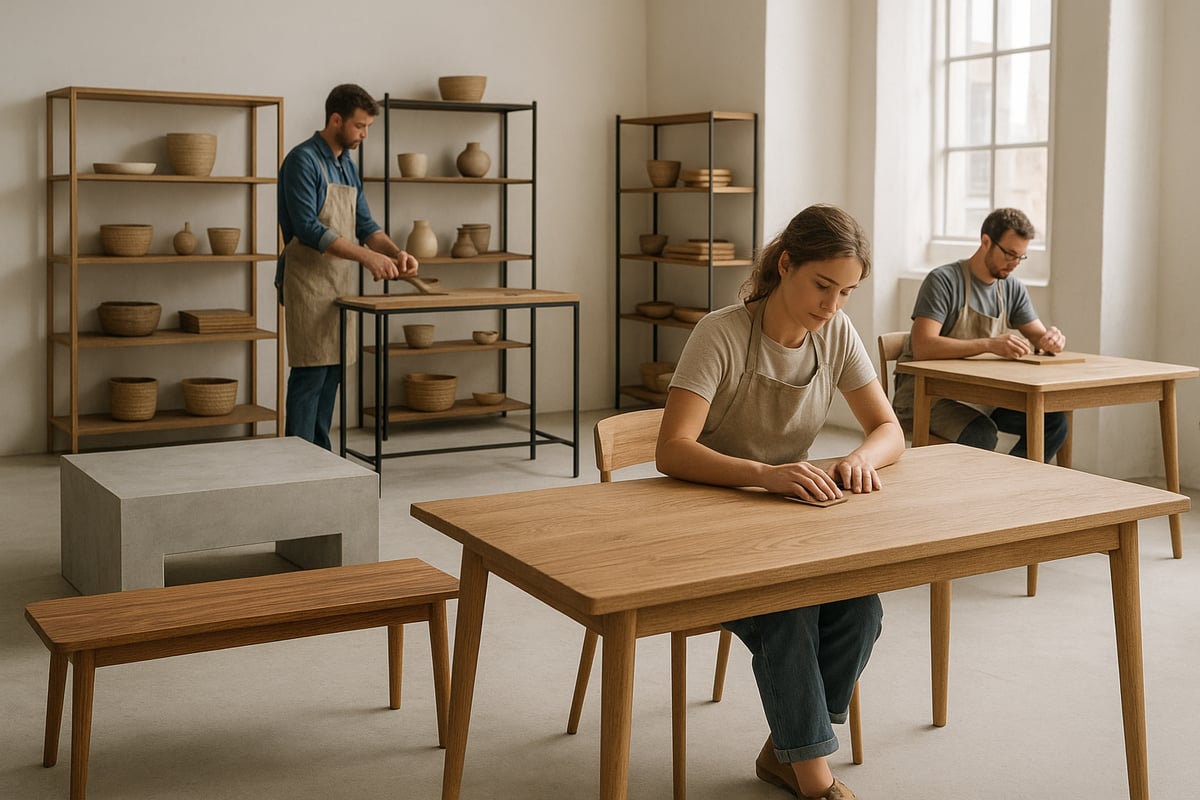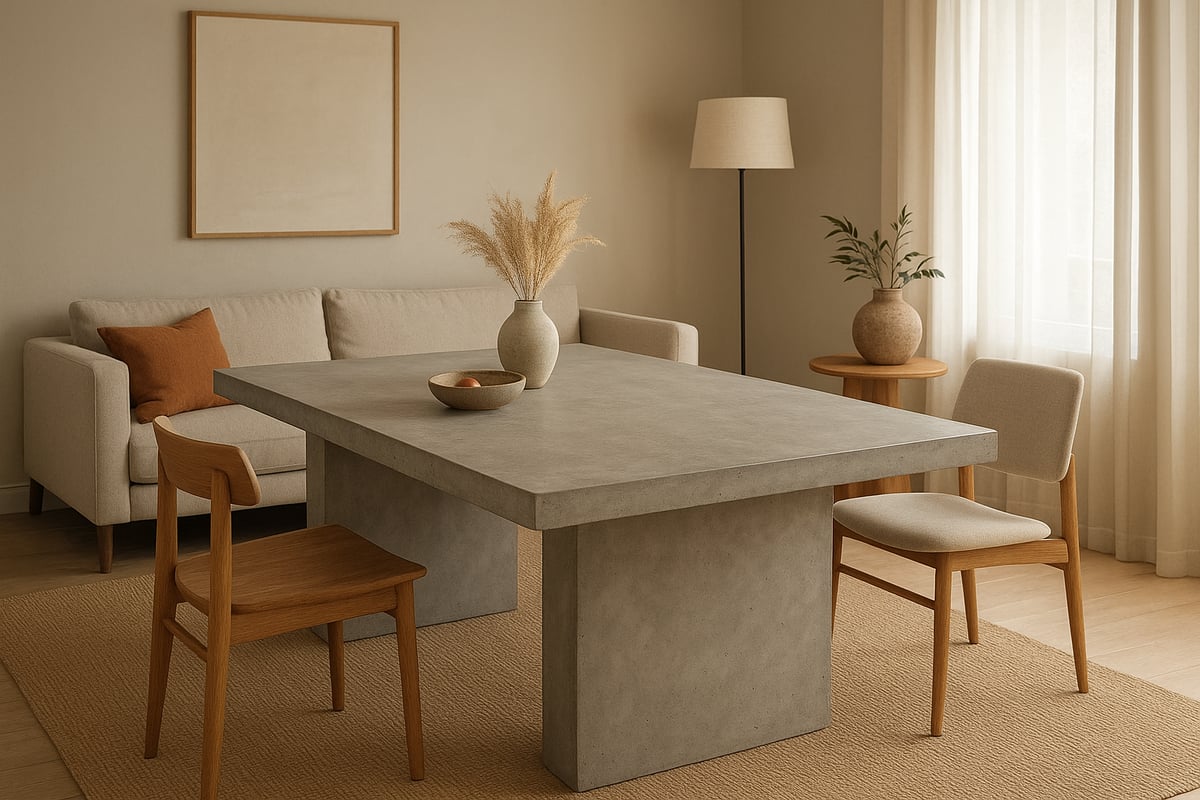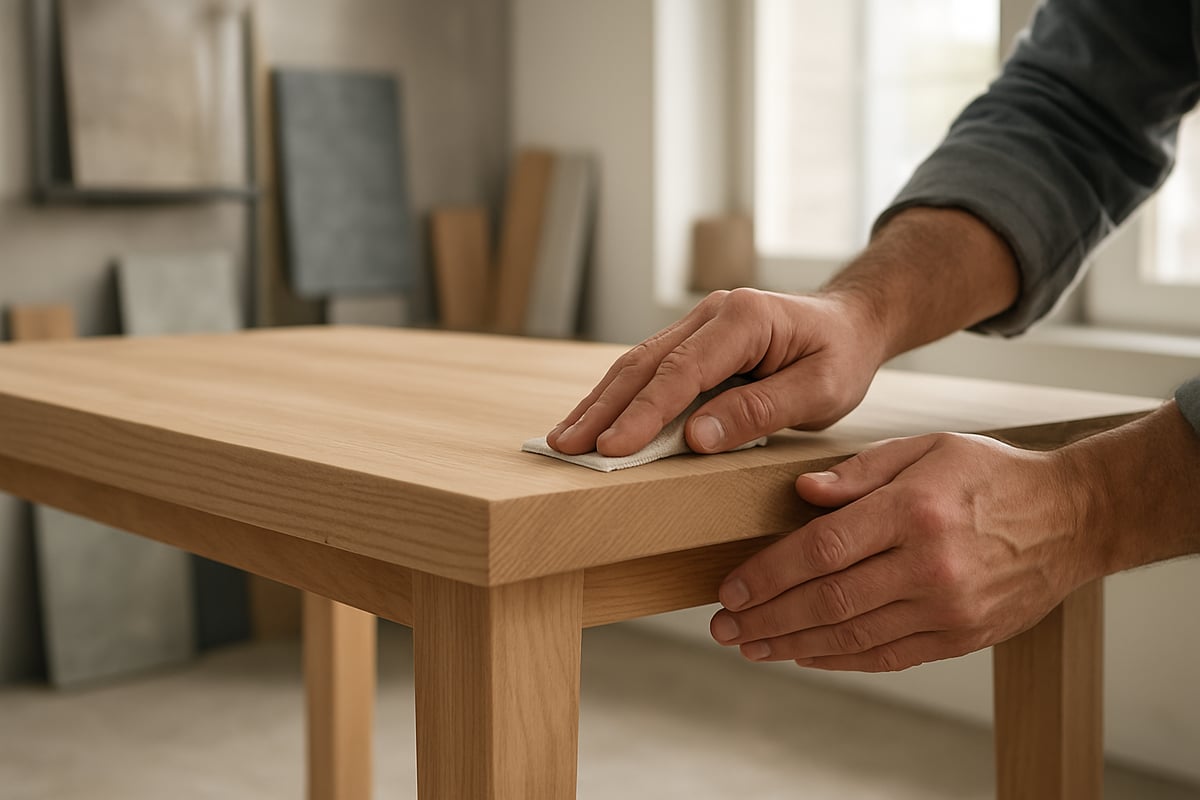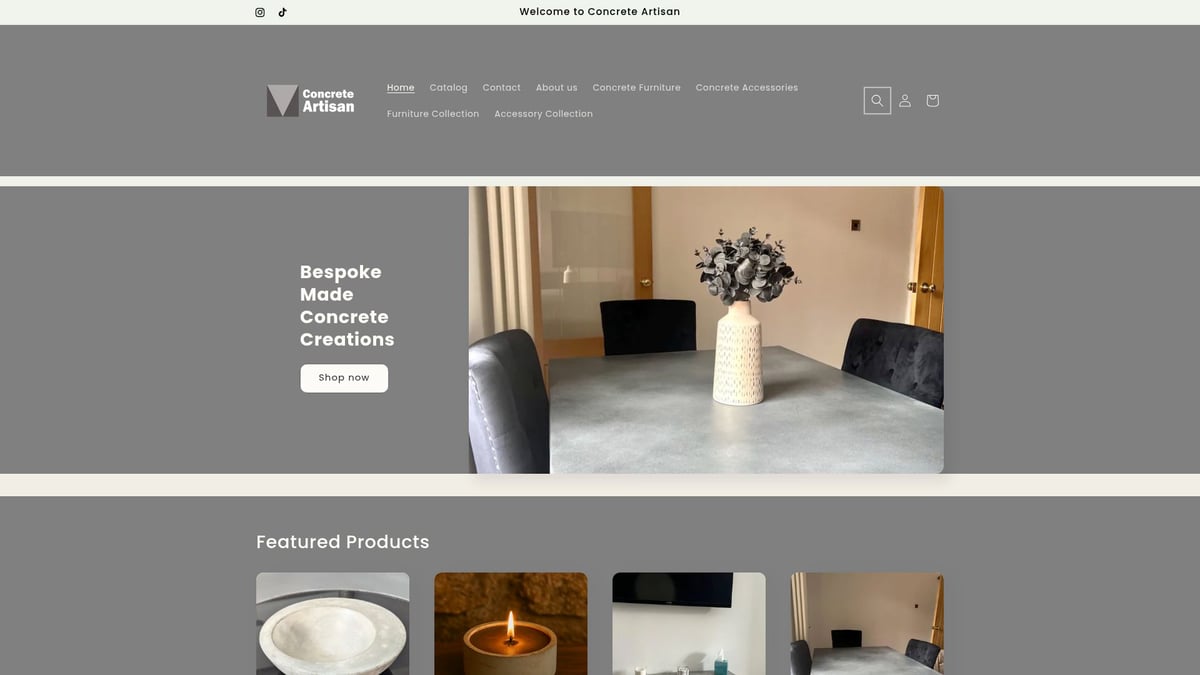
Handmade Furniture Shop Guide: Expert Tips for 2025
Share
Looking to transform your home with character and style? In 2025, the handmade furniture shop experience stands out as the premier choice for those seeking quality and individuality.
This guide will help you navigate the handmade furniture shop landscape. You will find expert tips, modern trends, and practical steps for making confident, value-driven purchases.
Explore the benefits of artisan craftsmanship, learn how to spot true quality, and discover how to personalize your space. Let’s unlock the secrets to finding the perfect piece for your home.
Understanding the Handmade Furniture Market in 2025
The handmade furniture shop landscape in 2025 is transforming, driven by a surge in demand for unique, sustainable, and customizable pieces. As consumers seek more than just functional décor, the appeal of artisanal craftsmanship is reshaping how people furnish their homes. In this section, we explore the trends, differences, and value that define the modern handmade furniture shop experience.

Key Trends Shaping the Industry
The handmade furniture shop sector is embracing several pivotal trends in 2025. Sustainability is at the forefront, with 70% of consumers prioritizing eco-friendly materials. Artisans are turning to reclaimed wood, bamboo, and low-impact finishes to meet this demand. For a deeper dive into sustainable practices, see this overview of Sustainable Materials in Custom Furniture.
Customization has become mainstream, as shoppers desire furniture tailored to their space and style. The rise of online marketplaces and virtual showrooms allows buyers to browse and commission pieces from anywhere, making the handmade furniture shop more accessible than ever.
Design trends in 2025 are equally dynamic. Industrial, minimalist, and organic styles are dominating interiors. Mixed materials—like wood, metal, and concrete—bring unique character to each piece. Social media and influencer marketing are powerful drivers, shaping tastes and helping buyers discover new artisans. More shoppers are supporting local makers, valuing transparency and community connections at their favorite handmade furniture shop.
How Handmade Differs from Mass-Produced Furniture
A handmade furniture shop offers a distinct experience compared to mass-market retailers. Each piece is crafted with care, resulting in one-of-a-kind items that showcase the artisan's skill. Unlike factory lines, no two pieces are identical, giving each purchase a personal touch.
Durability is another hallmark. Quality materials and time-tested techniques mean handmade furniture often lasts decades, outpacing mass-produced alternatives. Consider a bespoke dining table—expertly joined and finished, it stands the test of time, while many store-bought options may show wear within years.
Handmade furniture shops also prioritize ethical production. Small-batch manufacturing ensures better working conditions and responsible sourcing. While the initial investment can be higher, the long-term value, exclusivity, and satisfaction far outweigh the upfront cost.
Key differences include:
- Unique craftsmanship and artistry
- Superior durability and longevity
- Ethical, small-scale production
- Higher initial cost, greater lifetime value
These qualities set the handmade furniture shop apart, making it a preferred choice for discerning buyers.
The Value Proposition: Why Choose Handmade?
Choosing a handmade furniture shop means investing in artistry, heritage, and a story. Buyers can customize size, finish, and materials, ensuring every piece fits their vision and space. The option to tailor details—whether a matte concrete surface or a reclaimed wood base—adds both function and flair.
Handmade pieces often appreciate in value, with some becoming cherished heirlooms. The emotional connection to the maker and the narrative behind each item enriches the ownership experience. According to recent data, 60% of buyers report higher satisfaction with handmade purchases compared to mass-produced options.
A handmade furniture shop offers:
| Benefit | Description |
|---|---|
| Customization | Tailor size, materials, finishes |
| Lasting Value | Durable, heirloom-quality construction |
| Emotional Connection | Personal story and artisan relationship |
| Higher Satisfaction | Proven buyer contentment and pride |
Ultimately, a handmade furniture shop delivers more than just furniture—it offers timeless value, beauty, and a connection that lasts.
Step-by-Step Guide to Shopping for Handmade Furniture
Shopping at a handmade furniture shop in 2025 offers unmatched opportunities for customization, quality, and personal expression. However, the process requires a thoughtful approach to ensure you find the perfect piece that fits your space, needs, and style. This guide walks you through each essential step for making a confident, informed purchase.

Step 1: Define Your Needs and Preferences
Before visiting a handmade furniture shop, assess your living space and clarify what you truly need. Measure your room to determine the maximum size for your new piece. Consider how you use the space: Do you need extra storage, flexible seating, or a statement piece for entertaining?
List your must-have features:
- Storage options (drawers, shelves)
- Seating capacity for dining tables
- Style preferences (industrial, minimalist, organic)
- Preferred materials and finishes
By thoughtfully defining your needs, you will streamline your search at any handmade furniture shop and avoid costly mistakes.
Step 2: Set a Realistic Budget
Budgeting is a crucial step that ensures your experience at a handmade furniture shop remains enjoyable and stress-free. Understand that handmade pieces often cost more than mass-produced alternatives, but the investment pays off in durability and uniqueness.
Factor in:
- Base price for custom work
- Additional costs for premium materials or finishes
- Shipping, delivery, and installation fees
Compare prices across different handmade furniture shop options and use competitor benchmarks to gauge fair value. Remember to set aside a contingency fund for unexpected expenses.
Step 3: Research Artisans and Shops
Selecting the right artisan or handmade furniture shop can make all the difference. Start by exploring portfolios to review previous work and get a sense of each maker’s style and capabilities. Pay attention to reviews, testimonials, and ratings on trusted platforms.
Tips for evaluating shops:
- Look for detailed project galleries
- Read verified customer feedback
- Join design forums or online communities for recommendations
Connecting with design professionals or local enthusiasts can also help you find a handmade furniture shop with a solid reputation.
Step 4: Evaluate Quality and Craftsmanship
Quality is the hallmark of any reputable handmade furniture shop. When assessing options, inspect the joinery, finishes, and hardware. High-quality pieces feature seamless joints, smooth surfaces, and consistent finishes.
Ask questions about:
- Material sourcing (solid wood, high-grade metals, concrete)
- Construction techniques
- Warranty or guarantees
Request photos or videos of the making process when possible. Be wary of red flags such as uneven surfaces, poor alignment, or lack of transparency from the handmade furniture shop.
Step 5: Communicate and Customize
Clear communication with your chosen handmade furniture shop is essential for a successful project. Share your vision, measurements, and practical requirements in detail. Use sketches, mood boards, or inspiration photos to convey your ideas.
Discuss:
- Customization options for size, finish, or mixed materials
- Lead times, delivery, and aftercare services
- Written confirmation of all order details
A collaborative approach ensures the final piece meets your expectations and fits seamlessly into your space.
Step 6: Finalize Purchase and Delivery
Once you are satisfied with your choice, review the purchase agreement from your handmade furniture shop carefully. Understand payment terms, required deposits, and cancellation policies. Arrange for delivery, assembly, or installation as needed.
Upon delivery:
- Inspect the piece thoroughly
- Note any issues or discrepancies immediately
- Contact the shop for prompt resolution if needed
Proper planning at this stage protects your investment and guarantees a smooth experience with your handmade furniture shop.
Example: Buying a Custom Concrete Dining Table
Imagine you decide to purchase a bespoke concrete dining table from a handmade furniture shop. The process begins with an initial inquiry, where you discuss your dimensions, desired finish, and budget. Next, you review the artisan’s portfolio and request samples or sketches.
Throughout the project, you stay in close contact to confirm lead times and delivery logistics. Upon completion, the shop arranges installation and provides care instructions for your new centerpiece. For inspiration and to explore unique options, visit the Dining Tables Collection to see the range of handcrafted dining tables available.
By following these steps, you can confidently navigate the handmade furniture shop market and invest in a piece that truly reflects your style and values.
What to Look for: Quality Indicators in Handmade Furniture
Choosing the right piece at a handmade furniture shop requires a keen eye for quality. Understanding what sets true craftsmanship apart ensures your investment stands the test of time. Let’s break down the essential quality indicators every buyer should know.

Materials and Construction
The foundation of any exceptional handmade furniture shop piece lies in the materials. Look for solid hardwoods like oak, walnut, or maple, which provide strength and beauty. High grade metals and concrete offer modern durability and unique style.
Natural finishes, such as oils and non toxic sealants, protect surfaces without hiding the wood’s character. Skilled joinery, including dovetail and mortise and tenon, signals true craftsmanship. These construction methods ensure stability and longevity, making each piece a lasting addition to your home.
A reputable handmade furniture shop will always specify the materials used, giving you confidence in your purchase.
Workmanship and Detailing
Every handmade furniture shop is defined by the attention artisans give to detail. Consistency in finishes, seamless joints, and smooth, hand finished edges are hallmarks of superior work.
Authentic pieces often feature maker’s stamps or signature marks, proving their origin. Small details, like perfectly aligned hardware and invisible fixings, set high end items apart.
For a closer look at how these values are brought to life, explore the About Our Handmade Process page, which showcases the meticulous craftsmanship behind each item in a handmade furniture shop.
Durability and Functionality
A quality handmade furniture shop prioritizes durability and usability. Assess the weight, stability, and balance of each piece. Well constructed furniture should feel solid and remain steady on any surface.
Look for finishes that resist scratches, stains, and daily wear. Reinforced bases on items like concrete coffee tables add years to their lifespan. Functional design—such as smooth drawer slides or easy to clean surfaces—ensures your investment fits seamlessly into daily life.
Ask your handmade furniture shop about specific durability features, especially if you have children or high traffic spaces.
Transparency and Maker Communication
Open communication is a strong indicator of a trustworthy handmade furniture shop. Artisans should willingly share details about their process, materials, and care instructions.
Ask about available warranties or guarantees, which reflect confidence in their work. Beware of vague answers or missing documentation, as these are red flags. Reliable makers provide clear aftercare recommendations and welcome questions about customization or repairs.
A transparent handmade furniture shop builds lasting relationships with clients through honesty and support.
Customer Feedback and Case Studies
Before committing to a handmade furniture shop, review verified customer feedback and case studies. Authentic reviews offer insights into real world satisfaction and highlight the shop’s track record.
Look for before and after photos, which demonstrate transformation and quality. Success stories from other buyers can guide your expectations and inspire trust.
According to industry research, 85 percent of buyers consider reviews essential before purchasing from a handmade furniture shop. Let these shared experiences inform your decision and boost your confidence.
Customization and Personalization: Making Handmade Furniture Uniquely Yours
Customization is the heart of any handmade furniture shop experience. The ability to tailor each piece ensures that your furniture not only fits your space but also reflects your personal style. In 2025, buyers expect more than generic options. They seek meaningful choices that transform ordinary rooms into unique havens.
Exploring Customization Options
When shopping at a handmade furniture shop, the range of customization options is impressive. You can adjust dimensions to fit awkward corners or open spaces perfectly. Choices extend to finishes, from matte to high-gloss, and to colors that complement your palette.
Many shops offer mixed material designs, like combining reclaimed wood with industrial metal or concrete. For inspiration, browse curated selections such as the Concrete Furniture Collection, where you’ll find unique pieces tailored to modern tastes. Customization empowers you to create a statement piece that is both practical and visually striking.
Collaborating with Artisans
Effective collaboration is essential for a rewarding handmade furniture shop experience. Start by sharing your vision through mood boards, digital sketches, or photographs. This helps the artisan understand your style, desired features, and functional needs.
Open discussions about feasibility and timelines are crucial. Ask for material samples or prototypes if available. Confirm all specifications in writing, including measurements and finishes. Clear communication ensures your custom piece aligns with your expectations, resulting in a seamless process from concept to completion.
Balancing Creativity and Practicality
Creativity flourishes in a handmade furniture shop, yet practicality should never be overlooked. Consider how your custom design will serve daily life. Will it provide needed storage, maximize space, or offer multifunctional use?
Examples include extendable dining tables, integrated lighting, or custom shelving. Remember that a stunning design should also be comfortable and durable. Collaborate closely with the artisan to balance bold ideas with practical solutions, ensuring your investment enhances both form and function.
Cost and Lead Time Considerations
Understanding costs and timelines is vital when ordering from a handmade furniture shop. Complexity, material choice, and level of detail all influence the final price. Custom pieces generally require a lead time of 4 to 12 weeks in 2025, depending on the project scope.
Discuss your budget openly and ask for a detailed quote. Plan ahead to avoid delays, especially for intricate designs. Managing expectations around delivery and installation will help you enjoy the process as much as the finished product.
Caring for and Maintaining Handmade Furniture
Caring for pieces from your favorite handmade furniture shop is essential to preserving both their beauty and value. Thoughtful maintenance not only enhances everyday enjoyment but also safeguards your investment for years to come.
Best Practices for Different Materials
Every handmade furniture shop offers a variety of materials, each requiring specific care. For wooden pieces, use a gentle, damp cloth for cleaning and apply natural oils or waxes to maintain the finish. Avoid harsh chemicals that can strip the wood or damage its protective seal.
For metal furniture, dust regularly and use mild soap with water to clean. Wipe dry to prevent rust, especially on steel or iron. Concrete surfaces are durable yet benefit from periodic sealing to resist stains and moisture. For more insights on preserving the unique appeal of concrete, see the Beauty of Concrete Furniture.
Protect all finishes from direct sunlight, extreme heat, and humidity. For outdoor pieces, bring items indoors during harsh weather or use fitted covers.
Repair and Restoration
Even the highest-quality pieces from a handmade furniture shop may experience minor wear. Small scratches on wood can often be buffed with matching wax or touch-up markers. For chips in concrete, microcement kits offer an effective solution.
If you notice structural damage or finish issues, contact the artisan or the original handmade furniture shop for professional repairs. Many makers offer refinishing or restoration services, ensuring your furniture remains in top condition.
Taking prompt action prevents further deterioration and maintains the integrity of your investment.
Long-Term Preservation
Long-term care starts with regular rotation of your handmade furniture shop purchases, which prevents uneven fading and wear. Use felt pads under legs to protect floors and reduce stress on joints.
Store detachable accessories like cushions or glass tops in climate-controlled environments when not in use. For heirloom pieces, consider annual inspections to catch early signs of damage.
A simple maintenance schedule can dramatically extend the life of your favorite pieces.
Enhancing Longevity Through Proper Use
Proper usage is key to making the most of your handmade furniture shop selections. Always adhere to recommended weight limits, and avoid dragging items across the floor.
When moving larger pieces, enlist help to prevent undue stress on joints and surfaces. Use coasters, placemats, and protective pads to shield finishes from spills and heat.
Follow the maker’s care guidelines, as these are tailored to the specific materials and construction methods used. Many customers report their handmade furniture becoming cherished heirlooms, lasting for generations with consistent care.
Where to Shop: Top Destinations for Handmade Furniture in 2025
Navigating the handmade furniture shop landscape in 2025 is more exciting than ever. With a wide range of choices from digital marketplaces to local studios, finding the perfect piece is both accessible and rewarding. Whether you prefer browsing online or connecting with artisans in person, the right destination can help you discover furniture that truly fits your style and needs.
Online Marketplaces and Artisan Platforms
Online platforms have transformed the handmade furniture shop experience. Leading sites like Etsy and 1stDibs offer vast selections from global artisans, making it easy to compare styles, prices, and reviews. Virtual showrooms and augmented reality previews let you visualize pieces in your space before buying. According to Global Handmade Market Growth, interest in unique, artisanal pieces continues to surge, reflecting shifting consumer preferences.
Shopping online provides convenience and access to international makers. However, it is important to verify authenticity and review seller credentials to ensure a positive experience.
Local Workshops and Boutiques
Visiting a handmade furniture shop in your area offers a unique advantage. You can see craftsmanship up close, feel materials, and discuss ideas directly with makers. Local boutiques often host community events, giving you a chance to connect with artisans and other design enthusiasts.
Building relationships with local artists can lead to custom projects and ongoing support. In-person visits also help you gauge the quality and story behind each piece, making your purchase more meaningful.
Specialty Shops and Bespoke Studios
For those seeking one-of-a-kind pieces, specialty shops and bespoke studios are ideal. These handmade furniture shop destinations focus on unique materials like reclaimed wood or industrial concrete. Many studios offer full customization and design consultations to tailor each project to your needs.
To find niche artisans, explore online directories or ask for referrals from interior designers. According to Custom Furniture Market Analysis, the demand for personalized furniture continues to rise, with studios pushing the boundaries of material and design innovation.
Concrete Artisan: Bespoke Concrete Furniture & Decor
Concrete Artisan stands out as a top handmade furniture shop specializing in industrial-modern designs. Their offerings include handmade concrete tables, bowls, candles, and more, each crafted with meticulous attention to detail. Customers can request full customization, from size and finish to mixed-material combinations.

The studio is known for transparent pricing, responsive customer support, and professional delivery and installation services. Real-world client testimonials highlight the studio’s commitment to quality and satisfaction in modern living spaces.
Tips for Safe and Successful Purchases
Securing the best experience at any handmade furniture shop requires careful planning. Always verify business credentials and review return policies. Understand shipping, insurance, and installation logistics before making a purchase.
Leverage social media for inspiration and to connect with reputable makers. Check reviews and request documentation if needed. By following these steps, you can confidently invest in handcrafted pieces that will last for years to come.
